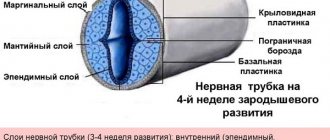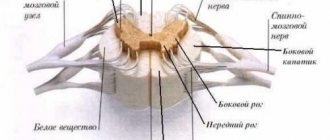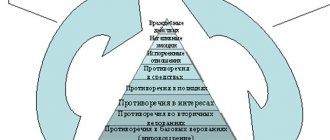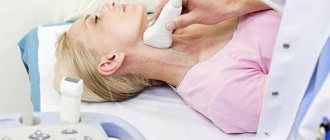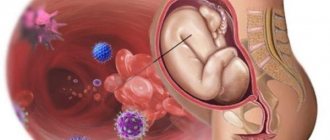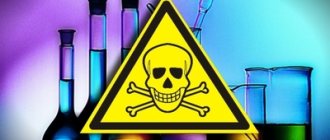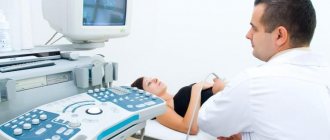Agenesis of the corpus callosum in the fetus is a congenital brain disease that is formed under the influence of genetically determined factors. This disease is an intrauterine pathology and occurs in very rare cases.
The corpus callosum is formed by nerve endings that intertwine with each other. The function of this anatomical formation is to connect the left and right hemispheres of the brain. The shape of the corpus callosum is wide and flat, and it is located under the cortex of the brain.
The formation of agenesis is observed in the complete absence of adhesions that connect both hemispheres. In terms of incidence, agenesis of the corpus callosum accounts for no more than 1 case per 2000 newborns.
Causes of pathology
Abnormal brain formation is always a congenital pathology; it appears quite rarely . From a morphological point of view, the failure occurs at approximately 10-20 weeks of pregnancy, when connective tissue begins to form.
The strength of severity and manifestation may differ: adhesions are either completely absent, or partial agenesis of the corpus callosum is detected. Factors that contribute to the development of this condition:
- changes in chromosomes, including hereditary ones;
- spontaneous mutations that have no explainable cause;
- intrauterine infection as a result of viral infection of the mother;
- the effect of narcotic substances and drugs;
- alcohol syndrome in the fetus due to maternal abuse;
- metabolic disorders in a woman or deficiency of nutrients in the embryo.
The disease is subject to intrauterine diagnosis, but the accuracy of determining agenesis of the corpus callosum is low.
Treatment and prevention
If the only healthy kidney functions normally, there are no symptoms and a characteristic enlargement of the organ is observed, then doctors will not take any additional actions to improve the functioning of the urinary system. The nephrologist will only prescribe dynamic monitoring of the kidney’s ability to produce and excrete urine, regular urinalysis and ultrasound examination.
Preventive actions are also provided that are aimed at preserving the functionality of the kidney:
- a diet that helps reduce the load on the only healthy organ is prescribed by a doctor, taking into account the individual characteristics of the patient;
- restrictions associated with contact sports (boxing, wrestling) to protect a healthy organ from injury and unnecessary damage;
- try not to lift heavy objects;
- maintain a constant body weight, avoid sudden weight loss;
- give up alcohol abuse and nicotine addiction;
- support the immune system with vitamins and minerals;
- avoid hypothermia to avoid the occurrence of infectious processes.
In the absence of function of the second kidney or with severe development of agenesis, when a healthy organ cannot cope with its work, intoxication with decay products and toxic substances occurs. In this case, hemodialysis and kidney transplantation are prescribed.
Clinical symptoms
In childhood, agenesis of the corpus callosum is detected; it manifests itself only in the case of a severe form, since it is accompanied by severe symptoms. In adults, agenesis of the corpus callosum is found incidentally, mainly during examination for other diseases. Often this pathology is mild and does not cause any difficulties in life.
In some infants, the disease is detected by 3-4 months of age, when developmental problems begin.
Agenesis of the corpus callosum is manifested by such first signs as: mild epileptic seizures, seizures and infantile spasms. Other symptoms, some of which can be detected during intrauterine examination:
- change in the process of formation of the corpus callosum;
- hydrocephalus or microencephaly;
- porencephaly, diseases of the mantle of the brain;
- atrophy of the auditory or optic nerves;
- syndrome of changes in spinal tissue, Aicardia;
- cysts and other neoplasms in the hemispheres;
- poorly formed convolutions;
- the appearance of lipomas;
- early sexual development in older age;
- abnormalities of internal organs;
- tumor processes often occur in the intestines and disturbances in the functioning of the gastrointestinal tract for no apparent reason;
- slow psychomotor development;
- somatic problems;
- poor coordination, weak muscles, skeletal abnormalities.
Agenesis of the corpus callosum in the fetus does not show any external signs.
Agenesis of the corpus callosum
Agenesis of the corpus callosum (ACC) is one of several disorders of the corpus callosum, the structure that connects the two hemispheres (left and right) of the brain. In AMT, the corpus callosum is partially or completely absent.
The disorder is caused by disruption of brain cell migration during fetal development. AMT may occur alone or in association with other cerebral disorders, including Arnold-Chiari malformation, Dandy-Walker syndrome, schizencephaly (clefts or deep compartments in the brain tissue), and holoprosencephaly (inability of the forebrain to divide into lobes).
Girls may have a gender-specific condition called Aicardi syndrome, which causes severe cognitive impairment and developmental delays, epilepsy, spinal abnormalities, and retinal lesions.
AMT may also be associated with malformations in other parts of the body, such as midline facial defects. The effects of the disorder range from subtle or mild to severe, depending on the associated abnormalities in the brain. Children with the most severe brain defects may have intellectual disabilities, seizures, hydrocephalus, and spasticity.
Other disorders of the corpus callosum include dysgenesis , in which the corpus callosum develops abnormally or defectively, and hypoplasia , in which the corpus callosum is thinner than normal.
People with these disorders have a higher risk of hearing loss and heart problems than people with normal structure.
Impairments in social interaction and communication in people with corpus callosum disorder may overlap with the behavior of autism spectrum disorders.
Causes of agenesis of the corpus callosum
In most cases, the cause of agenesis of the corpus callosum is unknown. However, agenesis of the corpus callosum can be inherited as an autosomal recessive trait or an X-linked dominant trait. This disorder may also be due in part to infection during pregnancy (in utero), which leads to abnormal brain development in the fetus.
Genetic diseases are determined by the combination of genes for a particular trait that are found on chromosomes received from the father and mother.
Recessive genetic disorders occur when a person inherits the same abnormal gene for one trait from each parent. If a person receives one normal gene and one gene for a disease, the person will be a carrier of the disease but will not usually exhibit symptoms.
The risk of two carrier parents passing on both defective genes and therefore having an affected child is 25% with each pregnancy. The risk of having a child who will be a carrier like the parents is 50% with each pregnancy.
The chance that a child will receive normal genes from both parents and be genetically normal for a given trait is 25%. The risk is the same for men and women.
In X-linked dominant disorders, a woman will develop the disease with only one X chromosome with the abnormal gene. However, a sick man always has a more severe condition.
Sometimes affected men die before birth, so that only the women survive. And then only with one of the forms of agenesis of the corpus callosum, known as Aicardi syndrome. The majority of patients diagnosed to date have been women.
Aicardi syndrome is sometimes seen in men with an extra X chromosome.
Signs and symptoms
Agenesis of the corpus callosum (ACC) may initially become apparent after the onset of epileptic seizures during the first weeks of life or during the first two years. However, not all people with AMT experience seizures.
Other symptoms that may begin early in life are problems with feeding and delays in holding the head upright. There may also be delays when sitting, standing and walking. Impaired mental and physical development and/or fluid buildup in the skull (hydrocephalus) are also symptoms of the early type of this disorder.
Neurological examination of patients with AMT can reveal:
- non-progressive mental retardation;
- impaired hand-eye coordination;
- deterioration of visual or auditory memory.
In some mild cases, symptoms may not appear for many years. Older patients are usually diagnosed during tests for symptoms such as epilepsy, monotone or repetitive speech, or headaches. In mild cases, the disorder may be missed due to a lack of obvious symptoms in childhood.
Some patients may have deep-set eyes and a prominent forehead. An abnormally small head (microcephaly) or sometimes an unusually large head (macrocephaly) may be present.
In other cases, AMT is observed:
- wide-set eyes (telanthus);
- small nose with inverted (anteverted) nostrils;
- abnormal ears;
- excessive skin on the neck;
- short arms;
- decreased muscle tone (hypotonia);
- laryngeal abnormalities;
- heart defects.
Aicardi syndrome , thought to be inherited as an X-linked dominant disorder, consists of agenesis of the corpus callosum, infantile spasms, and abnormal ocular structure.
This disorder is an extremely rare congenital disorder in which there are frequent seizures of epilepsy, abnormalities of the middle layer of the eye (choroid) and retinal layers, absence of the structure connecting the two hemispheres of the brain (corpus callosum), accompanied by severe mental retardation. Aicardi syndrome is mainly observed in women.
Andermann syndrome , identified in 1972, is a genetic disorder characterized by a combination of agenesis of the corpus callosum, mental retardation, and progressive sensorimotor disorders of the nervous system (neuropathies). The gene causing this rare form of agenesis of the corpus callosum has recently been identified, and genetic testing for this gene (SLC12A6) is now available.
X-linked lissencephaly with ambiguous genitalia is a rare genetic disorder in which men have a small and smooth brain (lissencephaly), a small penis, severe mental retardation and intractable epilepsy. It is caused by mutations in the ARX gene. In women, the same mutations can only cause AMT, while less severe mutations in men can cause mental retardation. Genetic testing for this disorder is also available.
Treatment of agenesis of the corpus callosum
Treatment is symptomatic and supportive. Anticonvulsants, special education, physical therapy, and related treatments may be helpful depending on the range and severity of symptoms.
If hydrocephalus is present, it can be treated with a surgical shunt to drain fluid from the brain cavity, thereby relieving the increased pressure on the brain.
Genetic counseling may also be helpful for families with this disorder.
Prognosis and complications of agenesis of the corpus callosum
The prognosis depends on the degree and severity of the malformations. Intellectual impairment does not worsen.
People with a corpus callosum disorder typically have delays in achieving developmental milestones such as walking, talking, or reading; problems with social interaction; clumsiness and poor motor coordination, especially in skills that require coordination of the left and right arms and legs (such as swimming, cycling and driving), and problems with mental and social perception that become more apparent with age, with problems especially manifest themselves in elementary school and into adulthood.
Source: //tvojajbolit.ru/nevrologiya/ageneziya_mozolistogo_tela/
Diagnostics
Ultrasound is most often used for detection. A specialist with sufficient experience and knowledge can accurately determine whether a child has agenesis of the corpus callosum. Additional techniques are used if the anomaly is partial and mild.
Additionally, patients are prescribed MRI and CT scan of the brain. Sometimes accompanying blood tests are required. It is very difficult to confuse agenesis with other diseases, but to be on the safe side, some experts advise seeking advice from 2 or more doctors to get a more complete picture of opinions.
Let me quote Mario from a recent forum on tuberous sclerosis.
Normal myelination After normal myelination in-utero, myelination of the neonatal brain is far from complete. The first myelination is seen as early as the 16th week of gestation, in the column of Burdach, but only really takes off from 24th week1.It does not reach maturity until 2 years or so. It correlates very closely to developmental milestones 3. The progression of myelination is predictable and abides by a few simple general rules; myelination progresses from: central to peripheral caudal to rostral dorsal to ventral Myelination milestones term birth : brainstem, cerebellum, posterior limb of the internal capsule 2 months : anterior limb of the internal capsule 3 months : splenium of the corpus callosum 6 months : genu of the corpus callosum Radiographic features CT
Unmyelinated white matter is hypodense compared to normal white matter and gray matter. MRI T1 weighted images is the most sensitive in children less than 1 year of age 1. T2 weighted images is the most sensitive in children between the age of 1 and 2 demonstrating a gradual shift from hyer- to hypo-intense relative to gray matter. The only area to remain hyperintense after the age of 2 years, and often for quite some time, is the peritrigonal region 4 FLAIR unsurprisingly follows the same pattern as T2 but lags behind somewhat. The exception is deep cerebral white matter, which begins as heterogenously hypointense during the first few months of life. This area then joins the remainder of white matter as hypointense before finally once more becoming hypointense in the second year of life 2 Proton density weighted images are useful in distinguishing gliosis from hypomylination.
In the acute setting DWI is more sensitive than either T1 or T2.
Fractional anisotropy (FA) increases with brain maturation (diffusion is restriced perpendicular to the direction of axons - thus the increase in DWI signal in large axon bundles running through the slice - eg posterior limb of interal capsule)
MRS demonstrates elevated myo-Inositol and Choline in neonates. NAA increases with myelination (in the first year of life).
Myelination pattern on MR imaging
Myelination of the brain during infantile progresses in an orderly and predictable fashion.
At birth only certain structures are myelinated dorsal brainstem ventrolateral thalamus lentiform nuclei central corticospinal tracts posterior portion of posterior of internal capsule
Subsequently different parts become myelinated, the first change is increase in T1 signal, and later decrease in T2 2 - 3 months : anterior limb of internal capsule becomes T1 bright 3 months : cerebellar white matter tracts becomes T1 bright 3 - 6 months : splenium of corpus callosum becomes T2 dark 6 months: genu of corpus callosum becomes T1 bright 8 months: subcortical white matter becomes T1 bright 8 months: genu of corpus callosum becomes T2 dark 11 months: anterior limb of internal capsule becomes T2 dark 1 year 2 months: occipital white matter becomes T2 dark 1 year 4 months : frontal white matter becomes T2 dark 1 1/2 years : majority of white matter becomes T2 dark (except terminal myelination zones adjacent to frontal horns and periatrial regions) 2 years : almost all of white matter becomes T2 dark
Is the pathology curable - video
Modern medicine cannot cure agenesis, but there are methods for correcting the disease. They are selected separately for each clinical case. The doctor takes into account the child’s general well-being, as well as the severity of agenesis of the corpus callosum.
Special medications are used to relieve symptoms. However, doctors are sure: most methods are not able to permanently relieve symptoms. Potent drugs are used for therapy:
- Phenobarbital . Reduces the number of attacks during infantile spasms.
- Benzidiazepines . Psychoactive products that inhibit psychomotor reactions and reduce the number of seizures.
- Corticosteroids . Necessary to combat epileptic seizures.
- Neuroleptics . Used to treat mental disorders.
- Nootropics . Used to correct brain functions.
- Diazepam . Corrects behavioral disorders.
- Neuropeptides . Improves communication between nerve endings.
In addition to medications, surgery is sometimes used to stimulate the vagus nerve. To do this, an electrical pulse generator is introduced.
Such an operation is possible only if agenesis of the corpus callosum threatens acute pathologies of important organs.
Surgery is also prescribed if other methods of therapy do not produce any results. The generator is installed in the subclavian area. After the stimulator is installed, the child should visit the doctor every few months. The advantage of installing a stimulator for agenesis of the corpus callosum is a significant reduction in the number of attacks .
Patients tolerate any symptoms better, but the device may not be effective in some situations. Sometimes pathology causes scoliosis, in which case exercise therapy and physiotherapy are prescribed for treatment. Less commonly, spinal surgery is required to improve the condition of bone tissue.
Treatment and prognosis
Agenesis of the right or left kidney does not pose a threat to the child’s life. Dynamic observation and adherence to doctor's recommendations are required. It is necessary to take care of a healthy organ and prevent bacterial diseases of the urinary system.
If there are no complaints with aplasia of the left or right kidney, a general clinical examination is performed once a year. The prognosis is favorable.
The diet should be balanced and fatty foods should be excluded. Heat treatment - baking, boiling, stewing. Fried and pickled foods should be excluded.
Alcohol is prohibited, as ethanol increases diuresis and stress on the only organ.
With the development of compensated renal failure, disability is issued. Depending on the patient's condition, the appropriate group is assigned.
If the kidney can cope with the load, there are no signs of chronic renal failure, then disability is not issued. The thermal stage of renal failure is an indication for organ transplantation; dialysis is performed.
Bilateral agenesis is incompatible with life. The child is stillborn or dies on the first day. As a rule, mothers are offered to terminate pregnancy and induce artificial birth.
But modern diagnostic methods make it possible to identify pathology in the prenatal period. After birth, organ transplantation is indicated.
The transplant is performed on the first day of the child’s life. Next, the patient needs hemodialysis. If organ rejection does not occur, if urodynamics are normal, the extrarenal blood purification procedure is canceled.
When treating diseases not related to the urinary system, a patient with a transplant or with unilateral agenesis should be prescribed drugs that do not have a nephrotoxic effect.
In addition, the active components of drugs should not be excreted in the urine.
There is no specific prophylaxis for diagnosed renal agenesis. The patient should monitor diet and avoid increased stress on the urinary system.
Pregnancy is possible, but it must be planned and desired. Abortion is not desirable. The presence of one kidney in the mother does not cause malformations in the fetus.
The woman should be under dynamic observation by a gynecologist. If a woman does not have any disturbances in the excretory function of the organ, hospitalization in the gynecological department is not required.
Childbirth is carried out according to the decision of the gynecologist. Both independent delivery and cesarean section are possible.
Prognosis for the disease
The development of partial agenesis of the corpus callosum in rare cases leads to pathologies that shorten the patient’s life. This form of the disease occurs in 80% of cases and is not accompanied by severe symptoms. Neurological correction, exercise therapy and physiotherapy are occasionally required.
However, pronounced forms and average degrees of pathology provoke various disorders. In this case, it is impossible to talk about a favorable prognosis. Most often, the main disorders are problems with intelligence, mental development, and severe neurological pathologies . Drug and folk therapy in this case does not give any effect.
Despite the favorable outcomes that occur, agenesis of the corpus callosum is a severe neurological disorder that cannot be successfully corrected. It is not possible to establish either the exact causes or factors that could reduce the number of manifestations of the pathology.
Agenesis of the corpus callosum is a complex brain disease that affects humans only at the stage of embryonic development. Despite this, it is found infrequently and in many cases does not cause any problems for patients. The timing of detection of the anomaly does not in any way affect the success of its treatment.

